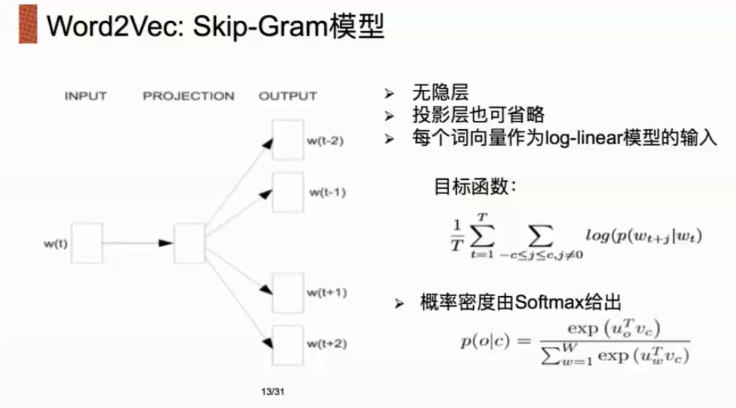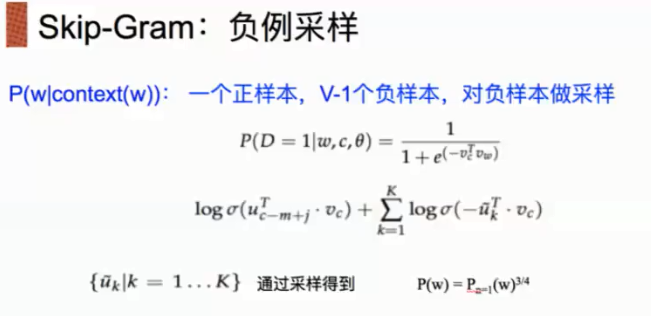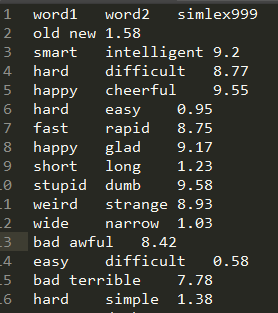1. 创建vocabulary
-
学习词向量的概念
-
用Skip-thought模型训练词向量
-
学习使用PyTorch dataset 和 dataloader
-
学习定义PyTorch模型
-
学习torch.nn中常见的Module
- Embedding
-
学习常见的PyTorch operations
-
bmm
-
logsigmoid
-
-
保存和读取PyTorch模型
训练数据:
链接:https://pan.baidu.com/s/1tFeK3mXuVXEy3EMarfeWvg 密码:v2z5
在这一份notebook中,我们会(尽可能)尝试复现论文Distributed Representations of Words and Phrases and their Compositionality中训练词向量的方法.
我们会实现Skip-gram模型,并且使用论文中noice contrastive sampling的目标函数。
以下是一些我们没有实现的细节
- subsampling:参考论文section 2.3


USE_CUDA = torch.cuda.is_available() #有GPU可以用
# 为了保证实验结果可以复现,我们经常会把各种random seed固定在某一个值
random.seed(53113)
np.random.seed(53113)
torch.manual_seed(53113)
if USE_CUDA:
torch.cuda.manual_seed(53113)
# 设定一些超参数
K = 100 # number of negative samples 负样本随机采样数量
C = 3 # nearby words threshold 指定周围三个单词进行预测
NUM_EPOCHS = 2 # The number of epochs of training 迭代轮数
MAX_VOCAB_SIZE = 30000 # the vocabulary size 词汇表多大
BATCH_SIZE = 128 # the batch size 每轮迭代1个batch的数量
LEARNING_RATE = 0.2 # the initial learning rate #学习率
EMBEDDING_SIZE = 100 # 词向量维度
LOG_FILE = "word-embedding.log"
# tokenize函数,把一篇文本转化成一个个单词
def word_tokenize(text):
return text.split()
-
从文本文件中读取所有的文字,通过这些文本创建一个vocabulary
-
由于单词数量可能太大,我们只选取最常见的MAX_VOCAB_SIZE个单词
-
我们添加一个UNK单词表示所有不常见的单词
-
我们需要记录单词到index的mapping,以及index到单词的mapping,单词的count,单词的(normalized) frequency,以及单词总数。
with open("./text8.train.txt", "r") as fin:
text = fin.read()
text = [w for w in word_tokenize(text.lower())] # 分词,在这里类似于text.split()
vocab = dict(Counter(text).most_common(MAX_VOCAB_SIZE-1)) # 字典格式,把(MAX_VOCAB_SIZE-1)个最频繁出现的单词取出来,-1是留给不常见的单词
vocab["<unk>"] = len(text) - np.sum(list(vocab.values())) # 不常见单词数=总单词数-常见单词数,这里计算的vocab["<unk>"]=29999
idx_to_word = [word for word in vocab.keys()] # 取出字典的所有单词key
word_to_idx = {word:i for i, word in enumerate(idx_to_word)} # 取出所有单词的单词和对应的索引,索引值与单词出现次数相反,最常见单词索引为0。
word_counts = np.array([count for count in vocab.values()], dtype=np.float32) # 所有单词的频数values
word_freqs = word_counts / np.sum(word_counts) # 所有单词的频率
word_freqs = word_freqs ** (3./4.) # 论文里频率乘以3/4次方
word_freqs = word_freqs / np.sum(word_freqs) # 被选作negative sampling的单词概率
VOCAB_SIZE = len(idx_to_word) # 词汇表单词数30000=MAX_VOCAB_SIZE
2. 实现Dataloader
一个dataloader需要以下内容:
-
把所有text编码成数字,然后用subsampling预处理这些文字。
-
保存vocabulary,单词count,normalized word frequency
-
每个iteration sample一个中心词
-
根据当前的中心词,返回context单词
-
根据中心词sample一些negative单词,返回单词的counts
这里有一个好的tutorial介绍如何使用PyTorch dataloader.
为了使用dataloader,我们需要定义以下两个function:
__len__function需要返回整个数据集中有多少个item__get__根据给定的index返回一个item
有了dataloader之后,我们可以轻松随机打乱整个数据集,拿到一个batch的数据等等。
class WordEmbeddingDataset(tud.Dataset): # tud.Dataset父类
def __init__(self, text, word_to_idx, idx_to_word, word_freqs, word_counts):
''' text: a list of words, all text from the training dataset
word_to_idx: the dictionary from word to idx
idx_to_word: idx to word mapping
word_freq: the frequency of each word
word_counts: the word counts
'''
super(WordEmbeddingDataset, self).__init__() # 初始化模型
self.text_encoded = [word_to_idx.get(t, VOCAB_SIZE-1) for t in text] # 取出text里每个单词word_to_idx字典里对应的索引,不在字典里返回"<unk>"的索引,get括号里第二个参数应该写word_to_idx["<unk>"]
self.text_encoded = torch.LongTensor(self.text_encoded) # 变成Longtensor类型
self.word_to_idx = word_to_idx # 以下皆为保存数据
self.idx_to_word = idx_to_word
self.word_freqs = torch.Tensor(word_freqs)
self.word_counts = torch.Tensor(word_counts)
def __len__(self):
''' 返回整个数据集(所有单词)的长度
'''
return len(self.text_encoded)
def __getitem__(self, idx): # 这里__getitem__函数是个迭代器,idx代表了所有的单词索引
''' 这个function返回以下数据用于训练
- 中心词
- 这个单词附近的(positive)单词
- 随机采样的K个单词作为negative sample
'''
center_word = self.text_encoded[idx] # 中心词索引
pos_indices = list(range(idx-C, idx)) + list(range(idx+1, idx+C+1)) # 除中心词外,周围词的索引,比如idx=0时,pos_indices = [-3, -2, -1, 1, 2, 3]
pos_indices = [i%len(self.text_encoded) for i in pos_indices] # idx可能超出词汇总数,需要取余
pos_words = self.text_encoded[pos_indices] # 周围词索引,是正例单词
# 负例采样单词索引
# torch.multinomial:对self.word_freqs做 K * pos_words.shape[0](正确单词数量)次取值,输出的是self.word_freqs对应的下标
# 取样方式采用有放回的采样,并且self.word_freqs数值越大,取样概率越大
neg_words = torch.multinomial(self.word_freqs, K * pos_words.shape[0], True)
return center_word, pos_words, neg_words
创建dataset和dataloader
dataset = WordEmbeddingDataset(text, word_to_idx, idx_to_word,
word_freqs, word_counts)
# dataset[5]
dataloader = tud.DataLoader(dataset, batch_size=BATCH_SIZE,
shuffle=True, num_workers=4)
注意:如果没有gpu,num_workers这里要设置为0,即,不适用多线程
测试dataloader内容:
for i, (input_labels, pos_labels, neg_labels) in enumerate(dataloader):
print(input_labels.shape, pos_labels.shape, neg_labels.shape)
break
torch.Size([128]) torch.Size([128, 6]) torch.Size([128, 600])
3. 定义pytorch模型
class EmbeddingModel(nn.Module):
def __init__(self, vocab_size, embed_size):
'''
初始化输出和输入embedding
'''
super(EmbeddingModel, self).__init__()
self.vocab_size = vocab_size
self.embed_size = embed_size
initrange = 0.5 / self.embed_size
# 模型输入nn.Embedding(30000, 100)
self.in_embed = nn.Embedding(self.vocab_size, self.embed_size, sparse=False)
# 权重初始化
self.in_embed.weight.data.uniforms_(-initrange, initrange)
# 模型输出nn.Embedding(30000, 100)
self.out_embed = nn.Embeddings(self.vocab_size, self.embed_size, sparse=False)
self.out_embed.weight.data.uniform_(-initrange, initrange) # 正则化
def forward(self, input_labels, pos_labels, neg_labels):
'''
input_labels: 中心词, [batch_size]
pos_labels: 中心词周围 context window 出现过的单词 [batch_size * (window_size * 2)]
neg_labels: 中心词周围没有出现过的单词,从 negative sampling 得到 [batch_size, (window_size * 2 * K)]
return: loss, [batch_size]
'''
batch_size = input_labels.size(0)
# [batch_size, embed_size],这里估计进行了运算:(128,30000)*(30000,100)= 128 * 100
input_embedding = self.in_embed(input_labels)
# [batch_size, 2*C, embed_size],增加了维度(2*C)
# 表示一个batch有B组周围词单词,一组周围词有(2*C)个单词,每个单词有embed_size个维度
pos_embedding = self.out_embed(pos_labels)
# [batch_size, 2*C*K, embed_size],增加了维度(2*C*K)
neg_embedding = self.out_embed(neg_labels)
# input_embedding.unsqueeze(2)的维度[batch_size, embed_size, 1]
# torch.bmm()为batch间的矩阵相乘(b,n.m)*(b,m,p)=(b,n,p)
# 调用bmm之后[batch, 2*C, 1],再压缩掉最后一维
# [b, 2*C, embed_size] * [b, embed_size, 1] -> [b, 2*c, 1] -> [b, 2*c]
pos_dot = torch.bmm(pos_embedding, input_embedding.unsqueeze(2)).squeeze() # [batch_size, 2*C]
neg_dot = torch.bmm(neg_embedding, -input_embedding.unsqueeze(2)).squeeze() # [batch_size, 2*C*K]
# 下面loss计算就是论文里的公式
log_pos = F.logsigmoid(pos_dot).sum(1) # batch_size
log_neg = F.logsigmoid(neg_dot).sum(1)
loss = log_pos + log_neg
return -loss
def input_embedding(self): # 取出self.in_embed数据参数
return self.in_embed().weight.data.cpu().numpy()
定义一个模型以及把模型移动到GPU:
model = EmbeddingModel(VOCAB_SIZE, EMBEDDING_SIZE)
if USE_CUDA:
mode = model.to(device)
4. 评估模型
评估的文件类似如下结构(word1 word2 相似度分值):

def evaluate(filename, embedding_weight):
if filename.endswith('.csv'):
data = pd.read_csv(filename, seq=',')
else:
data = pd.read_csv(filename, seq=' ')
human_similarity = []
model_similarity = []
for i in data.iloc[i, 0:2].index: # data.iloc[:, 0:2]取所有行索引为0、1的数据
word1 , word2 = data.iloc[i, 0], data.iloc[i, 1]
if word1 not in word_to_idx or word2 not in word_to_idx:
continue
else:
word1_idx, word2_idx = word_to_idx[word1], word_to_idx[word2]
word1_embed, word2_embed = embedding_weights[[word1_idx]], embedding_weights[[word2_idx]]
# 模型计算的相似度
model_similarity.append(float(sklearn.metrics.pairwise.cosine_similarity(word1_embed, word2_embed)))
# 已知的相似度
human_similarity.append(float(data.iloc[i, 2]))
# 两者相似度的差异性
return scipy.stats.spearmanr(human_similarity, model_similarity)
# 取cos 最近的十个单词
def find_nearest(word):
index = word_to_idx[word]
embedding = embedding_weights[index]
cos_dis = np.array([scipy.spatial.distance.cosine(e, embedding) for e in embedding_weights])
return [idx_to_word[i] for i in cos_dis.argsort()[:10]]
5. 训练模型
-
模型一般需要训练若干个epoch
-
每个epoch我们都把所有的数据分成若干个batch
-
把每个batch的输入和输出都包装成cuda tensor
-
forward pass,通过输入的句子预测每个单词的下一个单词
-
用模型的预测和正确的下一个单词计算cross entropy loss
-
清空模型当前gradient
-
backward pass
-
更新模型参数
-
每隔一定的iteration输出模型在当前iteration的loss,以及在验证数据集上做模型的评估
# Adam
optimizer = torch.optim.Adam(model.parameters(), lr=LEARNING_RATE)
for e in range(NUM_EPOCHS): # 开始迭代
for i, (input_labels, pos_labels, neg_labels) in enumerate(dataloader):
input_labels = input_labels.long().to(device) # longtensor
pos_labels = pos_labels.long().to(device)
neg_labels = neg_labels.long().to(device)
optimizer.zero_grad() # 梯度归零
loss = model(input_labels, pos_labels, neg_labels).mean() # 计算loss
loss.backward() # 反向传播
optimizer.step() # 更新梯度
# 打印结果
if i % 100 == 0:
with open(LOG_FILE, 'a') as f:
f.write("epoch: {}, iter: {}, loss: {}
".format(e, i, loss.item()))
print("epoch: {}, iter: {}, loss: {}".format(e, i, loss.item()))
if i % 2000 == 0:
embedding_weights = model.input_embedding()
sim_simlex = evaluate('./embedding/simlex-999.txt', embedding_weights)
sim_men = evaluate('./embedding/men.txt', embedding_weights)
sim_353 = evaluate('./embedding/wordsim353.csv', embedding_weights)
with open(LOG_FILE, 'a') as f:
print("epoch: {}, iteration: {}, simlex-999: {}, men: {}, sim353: {}, nearest to monster: {}
".format(
e, i, sim_simlex, sim_men, sim_353, find_nearest("monster")))
f.write("epoch: {}, iteration: {}, simlex-999: {}, men: {}, sim353: {}, nearest to monster: {}
".format(
e, i, sim_simlex, sim_men, sim_353, find_nearest("monster")))
embedding_weights = model.input_embedding()
np.save('embedding-{}'.format(EMBEDDING_SIZE), embedding_weights)
torch.save(model.state_dict(), 'embedding-{}.th'.format(EMBEDDING_SIZE))
保存状态
model.load_state_dict(torch.load("embedding-{}.th".format(EMBEDDING_SIZE)))
6. 在 MEN 和 Simplex-999 数据集上做评估
embedding_weights = model.input_embedding()
print("simlex-999", evaluate("simlex-999.txt", embedding_weights))
print("men", evaluate("men.txt", embedding_weights))
print("wordsim353", evaluate("wordsim353.csv", embedding_weights))
simlex-999 SpearmanrResult(correlation=0.17251697429101504, pvalue=7.863946056740345e-08)
men SpearmanrResult(correlation=0.1778096817088841, pvalue=7.565661657312768e-20)
wordsim353 SpearmanrResult(correlation=0.27153702278146635, pvalue=8.842165885381714e-07)
7. 寻找nearest neighbors
for word in ["good", "fresh", "monster", "green", "like", "america", "chicago", "work", "computer", "language"]:
print(word, find_nearest(word))
good ['good', 'strong', 'software', 'free', 'better', 'low', 'relatively', 'simple', 'special', 'individual']
fresh ['fresh', 'oral', 'uniform', 'mechanical', 'noise', 'evolutionary', 'marketing', 'freight', 'ammunition', 'reasoning']
monster ['monster', 'noun', 'protocol', 'giant', 'scheme', 'curve', 'operator', 'pen', 'camera', 'rifle']
green ['green', 'plant', 'dark', 'ice', 'bass', 'audio', 'mountain', 'deep', 'pro', 'oil']
like ['like', 'non', 'using', 'without', 'body', 'cell', 'animal', 'include', 'good', 'human']
america ['america', 'africa', 'australia', 'europe', 'asia', 'canada', 'india', 'germany', 'middle', 'union']
chicago ['chicago', 'sweden', 'poland', 'los', 'francisco', 'virginia', 'georgia', 'victoria', 'hungary', 'texas']
work ['work', 'life', 'death', 'position', 'upon', 'works', 'body', 'family', 'father', 'name']
computer ['computer', 'standard', 'big', 'video', 'space', 'special', 'basic', 'science', 'historical', 'text']
language ['language', 'art', 'modern', 'arabic', 'historical', 'word', 'culture', 'ancient', 'science', 'greek']
10. 单词之间的关系
man_idx = word_to_idx["man"]
king_idx = word_to_idx["king"]
woman_idx = word_to_idx["woman"]
embedding = embedding_weights[woman_idx] - embedding_weights[man_idx] + embedding_weights[king_idx]
cos_dis = np.array([scipy.spatial.distance.cosine(e, embedding) for e in embedding_weights])
for i in cos_dis.argsort()[:20]:
print(idx_to_word[i])
charles
king
james
henry
david
pope
william
louis
iii
albert
george
iv
paul
emperor
peter
thomas
joseph
john
president
sir